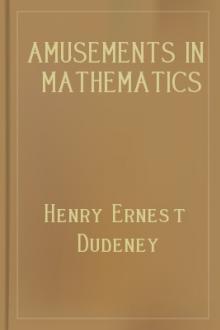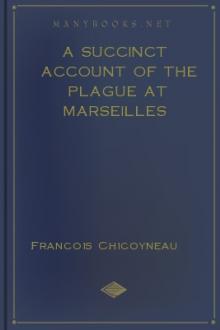Amusements in Mathematics, Henry Ernest Dudeney [books to read to be successful txt] 📗

- Author: Henry Ernest Dudeney
- Performer: 0486204731
Book online «Amusements in Mathematics, Henry Ernest Dudeney [books to read to be successful txt] 📗». Author Henry Ernest Dudeney
Having found the fewest possible passages, we should consider two other points in deciding on the "quickest method": Which persons were the most expert in handling the oars, and which method entails the fewest possible delays in getting in and out of the boat? We have no data upon which to decide the first point, though it is probable that, as the boat belonged to the girls' household, they would be capable oarswomen. The other point, however, is important, and in the solution I have given (where the girls do 8-13ths of the rowing and A and D need not row at all) there are only sixteen gettings-in and sixteen gettings-out. A man and a girl are never in the boat together, and no man ever lands on the island. There are other methods that require several more exchanges of places.
377.—STEALING THE CASTLE TREASURE.—solution
Here is the best answer, in eleven manipulations:—
378.—DOMINOES IN PROGRESSION.—solution
There are twenty-three different ways. You may start with any domino, except the 4—4 and those that bear a 5 or 6, though only certain initial dominoes may be played either way round. If you are given the common difference and the first domino is played, you have no option as to the other dominoes. Therefore all I need do is to give the initial domino for all the twenty-three ways, and state the common difference. This I will do as follows:—
With a common difference of 1, the first domino may be either of these: 0—0, 0—1, 1—0, 0—2, 1—1, 2—0, 0—3, 1—2, 2—1, 3—0, 0—4, 1—3, 2—2, 3—1, 1—4, 2—3, 3—2, 2—4, 3—3, 3—4. With a difference of 2, the first domino may be 0—0, 0—2, or 0—1. Take the last case of all as an example. Having played the 0—1, and the difference being 2, we are compelled to continue with 1—2, 2—3, 3—4. 4—5, 5—6. There are three dominoes that can never be used at all. These are 0—5, 0—6, and 1—6. If we used a box of dominoes extending to 9—9, there would be forty different ways.
379.—THE FIVE DOMINOES.—solution
There are just ten different ways of arranging the dominoes. Here is one of them:—
(2—0) (0—0) (0—1) (1—4) (4—0).
I will leave my readers to find the remaining nine for themselves.
380.—THE DOMINO FRAME PUZZLE.—solution

The illustration is a solution. It will be found that all four sides of the frame add up 44. The sum of the pips on all the dominoes is 168, and if we wish to make the sides sum to 44, we must take care that the four corners sum to 8, because these corners are counted twice, and 168 added to 8 will equal 4 times 44, which is necessary. There are many different solutions. Even in the example given certain interchanges are possible to produce different arrangements. For example, on the left-hand side the string of dominoes from 2—2 down to 3—2 may be reversed, or from 2—6 to 3—2, or from 3—0 to 5—3. Also, on the right-hand side we may reverse from 4—3 to 1—4. These changes will not affect the correctness of the solution.
381.—THE CARD FRAME PUZZLE.—solution
The sum of all the pips on the ten cards is 55. Suppose we are trying to get 14 pips on every side. Then 4 times 14 is 56. But each of the four corner cards is added in twice, so that 55 deducted from 56, or 1, must represent the sum of the four corner cards. This is clearly impossible; therefore 14 is also impossible. But suppose we came to trying 18. Then 4 times 18 is 72, and if we deduct 55 we get 17 as the sum of the corners. We need then only try different arrangements with the four corners always summing to 17, and we soon discover the following solution:—

The final trials are very limited in number, and must with a little judgment either bring us to a correct solution or satisfy us that a solution is impossible under the conditions we are attempting. The two centre cards on the upright sides can, of course, always be interchanged, but I do not call these different solutions. If you reflect in a mirror you get another arrangement, which also is not considered different. In the answer given, however, we may exchange the 5 with the 8 and the 4 with the 1. This is a different solution. There are two solutions with 18, four with 19, two with 20, and two with 22—ten arrangements in all. Readers may like to find all these for themselves.
382.—THE CROSS OF CARDS.—solution
There are eighteen fundamental arrangements, as follows, where I only give the numbers in the horizontal bar, since the remainder must naturally fall into their places.
It will be noticed that there must always be an odd number in the centre, that there are four ways each of adding up 23, 25, and 27, but only three ways each of summing to 24 and 26.
383.—THE "T" CARD PUZZLE.—solution
If we remove the ace, the remaining cards may he divided into two groups (each adding up alike) in four ways; if we remove 3, there are three ways; if 5, there are four ways; if 7, there are three ways; and if we remove 9, there are four ways of making two equal groups. There are thus eighteen different ways of grouping, and if we take any one of these and keep the odd card (that I have called "removed") at the head of the column, then one set of numbers can be varied in order in twenty-four ways in the column and the other four twenty-four ways in the horizontal, or together they may be varied in 24 × 24 = 576 ways. And as there are eighteen such cases, we multiply this number by 18 and get 10,368, the correct number of ways of placing the cards. As this number includes the reflections, we must divide by 2, but we have also to remember that every horizontal row can change places with a vertical row, necessitating our multiplying by 2; so one operation cancels the other.
384.—CARD TRIANGLES.—solution
The following arrangements of the cards show (1) the smallest possible sum, 17; and (2) the largest possible, 23.

It will be seen that the two cards in the middle of any side may always be interchanged without affecting the conditions. Thus there are eight ways of presenting every fundamental arrangement. The number of fundamentals is eighteen, as follows: two summing to 17, four summing to 19, six summing to 20, four summing to 21, and two summing to 23. These eighteen fundamentals, multiplied by eight (for the reason stated above), give 144 as the total number of different ways of placing the cards.
385.—"STRAND" PATIENCE.—solution
The reader may find a solution quite easy in a little over 200 moves, but, surprising as it may at first appear, not more than 62 moves are required. Here is the play: By "4 C up" I mean a transfer of the 4 of clubs with all the cards that rest on it. 1 D on space, 2 S on space, 3 D on space, 2 S on 3 D, 1 H on 2 S, 2 C on space, 1 D on 2 C, 4 S on space, 3 H on 4 S (9 moves so far), 2 S up on 3 H (3 moves), 5 H and 5 D exchanged, and 4 C on 5 D (6 moves), 3 D on 4 C (1), 6 S (with 5 H) on space (3), 4 C up on 5 H (3), 2 C up on 3 D (3), 7 D on space (1), 6 C up on 7 D (3), 8 S on space (1), 7 H on 8 S (1), 8 C on 9 D (1), 7 H on 8 C (1), 8 S on 9 H (1), 7 H on 8 S (1), 7 D up on 8 C (5), 4 C up on 5 D (9), 6 S up on 7 H (3), 4 S up on 5 H (7) = 62 moves in all. This is my record; perhaps the reader can beat it.
386.—A TRICK WITH DICE.—solution
All you have to do is to deduct 250 from the result given, and the three figures in the answer will be the three points thrown with the dice. Thus, in the throw we gave, the number given would be 386; and when we deduct 250 we get 136, from which we know that the throws were 1, 3, and 6.
The process merely consists in giving 100a + 10b + c + 250, where a, b, and c represent the three throws. The result is obvious.
387.—THE VILLAGE CRICKET MATCH.—solution

The diagram No. 1 will show that as neither Mr. Podder nor Mr. Dumkins can ever have been within the crease opposite to that from which he started, Mr. Dumkins would score nothing by his performance. Diagram No. 2 will, however, make it clear that since Mr. Luffey and Mr. Struggles have, notwithstanding their energetic but careless movements, contrived to change places, the manœuvre must increase Mr. Struggles's total by one run.
388.—SLOW CRICKET.—solution
The captain must have been "not out" and scored 21. Thus:—
The captain thus scored exactly 15 more than the average of the team. The "others" who were bowled could only refer to three men, as the eleventh man would be "not out." The reader can discover for himself why the captain must have been that eleventh man. It would not necessarily follow with any figures.
389.—THE FOOTBALL PLAYERS.—solution
The smallest possible number of men is seven. They could be accounted for in three different ways: 1. Two with both arms sound, one with broken right arm, and four with both arms broken. 2. One with both arms sound, one with broken left arm, two with broken right arm, and three with both arms broken. 3. Two with left arm broken, three with right arm broken, and two





Comments (0)